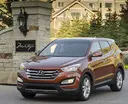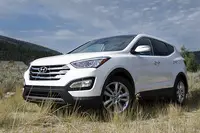2013 Hyundai Santa Fe Sport CUV Makeover - By Thom Cannell
Hyundai’s 2013 Santa Fe Sport is completely new and I believe can go toe to toe with its many CUV rivals…
By Thom Cannell
Michigan Bureau
The Auto Channel
45 million Americans say they are on a diet to shed weight and build muscle. One “loser” is Hyundai’s 2013 Santa Fe Sport CU, it’s been to the gym, had a total body makeover and dropped a whopping 266 pounds. Santa Fe Sport has been recreated, reinvigorated, and head to toe reborn.
The outgoing Santa Fe and its larger Veracruz cousin were competitive in the mid-sized crossover utility vehicle (CUV) segment against Ford Escape and Explorer, Nissan Rogue and Pathfinder, Toyota RAV4 and Highlander. For 2013 Hyundai decided to end production of Veracruz, offering only Santa Fe with two wheelbases and seating arrangements.
 |
Santa Fe Sport is completely new and we believe goes toe to toe with the rivals just mentioned and big names in the European luxury category. It is handsome, nimble, powerful, and exceptionally quiet. As do all Hyundai, Sport offers great value in its price, particularly when its lengthy standard features are considered.
Prices begin at $24,450 for the base FWD (front wheel drive) model equipped with standard 2.4-liter engine and six-speed automatic and go to $29,450 for a Sport with All Wheel Drive, 2.0-liter turbocharged engine and six-speed transmission. Unlike some manufacturers Hyundai makes AWD available across the model line, adding about $2000 to the bottom line.
It’s difficult to known how to describe Santa Fe’s appeal, it suits multiple situations. If you’re a family features like stain-resistant cloth seats from Yes Essentials, a fully equipped audio system (AM-FM, CD/MP3, SiriusXM, iPod, USB/Aux inputs), BlueLink Telematics, remote keyless entry, hill start assistance and downhill brake control, and complete air bags including driver’s knee protection might be as important as the available backup camera, Or families might focus on assistive technologies that help with hill starts, assistance in emergency braking and traction control, or better control going down steep hills.
 |
If the kids are gone perhaps amenities like in wheel controls for audio, mobile phone, and cruise control might suit you. Trailer preparation, illuminated vanity mirrors in each sun shade, and LED accented headlamps might also sway your vote. For some the standard active ECO system that smooths out throttle application to save fuel could make the sale. We’ll begin by focusing on Hyundai’s weight loss because exceptional body strength and maneuverability are important to every driver and passenger.
Weight loss benefits a car the same as humans. Shedding pounds and adding muscle makes you, or your car, more energetic and powerful. At the start of construction Hyundai set a goal of losing 10% of its body mass, which is as much a nightmare for an engineer as you and I. To make it tragically difficult, product planners added safety features like additional roof strength and knee airbags that weighed 31 pounds; 38 pounds of sound deadening including an undertray and a few more pounds elsewhere. Yes, they were told “lose weight even after we add on 89 pounds!”
Their solution was to use even more high strength steel and smarter
engineering. High strength steel is important for safety. For instance by
using extremely tough steel you can form a safety cage similar to a NASCAR
race vehicle, with
 |
It surely helps that Hyundai owns its own steel company, replete with 400 engineers. The smart engineering does things like understand where steel needs to be thick, where it can be thinner, then laser weld two different thickness together before a part is shaped. The result will be lighter and stronger. The last few pounds came from little things, like networking most of the electronics, lighter weight suspension parts, even replacing some aluminum parts with lighter, stronger, and quieter engineered resins.
For Santa Fe the outcome was an overall weight loss of 266 pounds and, like the Biggest Loser, with the backpack removed, the vehicle should feel quite frisky with the standard 2.4-liter 190 horsepower Direct Injected engine.
Muscular development followed nontraditional methods. Instead of a V-6 (standard on next year’s longer 6-7 passenger model) Hyundai offers its now-familiar 2.0-liter twin-scroll turbocharged engine on all Sport models. It’s not only powerful — 264 horses and 269 pound-feet of torque — but that power feels more like a V-6 or small V-8 because torque, the power you feel develops just above idle and continues strongly to the red line above 6,000 rpm.
How much difference does a turbo make? If you live at sea level it’s a big difference. In the mountains of Utah where we tested, it’s huge because every 1,000 feet of altitude steals 10% of power. A turbocharger makes up most or all loss by stuffing more oxygen-containing air molecules into the combustion chamber.
 |
 |
 |
Après spa treatments and the months of personal training, Santa Fe emerges lighter, tougher, and better looking. While the elder models remain contemporary, with Hyundai’s fluidic design it is much better looking, though not as edgy as some models. Thus it should remain in style for many years, adding value to your purchase.



